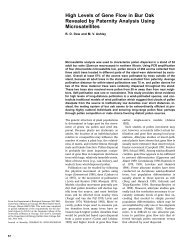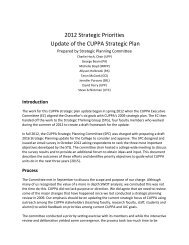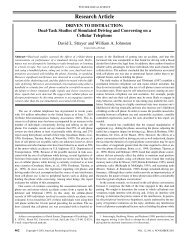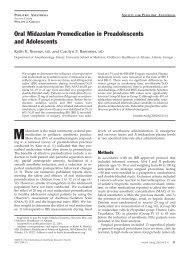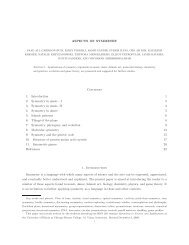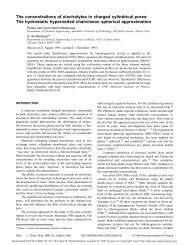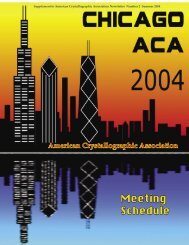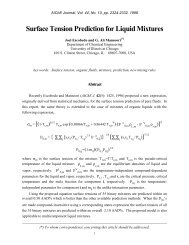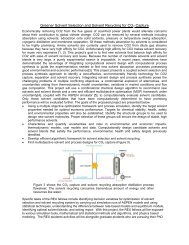Structure & Properties of Micelles and Micelle Coacervates of ...
Structure & Properties of Micelles and Micelle Coacervates of ...
Structure & Properties of Micelles and Micelle Coacervates of ...
Create successful ePaper yourself
Turn your PDF publications into a flip-book with our unique Google optimized e-Paper software.
Figure 7 Figure 8<br />
According to Figure 7, two distinct points <strong>of</strong> change <strong>of</strong> slope for the relative viscosity versus concentration<br />
<strong>of</strong> asphaltene in solvent are recognized in the 0-1 mg/g concentration range. The lower-concentration change <strong>of</strong><br />
slope point represents the critical micellization concentration (CMC) <strong>of</strong> asphaltene <strong>and</strong> the other (higher<br />
concentration) change <strong>of</strong> slope point represents the completion <strong>of</strong> micellization (or micellization saturation) point.<br />
According to Figure 8 also two distinct points <strong>of</strong> change <strong>of</strong> slope for the relative viscosity versus concentration <strong>of</strong><br />
asphaltene in solvent are recognized in the 1-10 mg/g concentration range. The lower-concentration change <strong>of</strong> slope<br />
point corresponds to the micelles coacervation point (MCP) <strong>of</strong> asphaltene <strong>and</strong> the other (higher concentration)<br />
change <strong>of</strong> slope represents the coacervate separation point. By repeating the relative viscosity measurement at<br />
various other temperatures in the range <strong>of</strong> 0-160 oC, <strong>and</strong> various concentrations <strong>of</strong> asphaltenes in polar solvents<br />
similar figures, as Figures 6-8, were obtained which provided us with the necessary data to construct the<br />
micellization, saturation, coacervation <strong>and</strong> phase separation diagrams <strong>of</strong> asphaltene in polar solvents as reported in<br />
Figures 9 <strong>and</strong> 10.<br />
Temperature, oC<br />
160<br />
140<br />
120<br />
100<br />
80<br />
60<br />
40<br />
20<br />
0<br />
0.01 0.1 1 10<br />
Concentration, mg/g<br />
CMC<br />
Sat.point<br />
Coac.point<br />
Separ.point<br />
Temperature, oC<br />
180<br />
160<br />
140<br />
120<br />
100<br />
80<br />
60<br />
40<br />
20<br />
0<br />
0.01 0.1 1 10<br />
CMC, mg/g<br />
CMC<br />
Sat.point<br />
Coac.point<br />
Separ.point<br />
Figure 9 Figure 10<br />
Figure 9 shows the measured data for phase diagram <strong>of</strong> PIBF asphaltene dissolved in 1-methyl naphthalene,<br />
which includes the CMC, saturation point, MCP <strong>and</strong> separation point for the temperature range <strong>of</strong> 0 - 160 o C with<br />
10 o C increment. According to this figure the CMC, saturation point, MCP <strong>and</strong> separation point get closer to one<br />
another as temperature increases. Figure 10 shows the measured data obtained for the phase diagram <strong>of</strong> AMHR<br />
asphaltene which has concentrations <strong>of</strong> 1.0 - 10.0 mg/g in 1-methyl naphthalene at the temperatures range <strong>of</strong> 0-<br />
180 o C. This data also includes the CMC, saturation point, MCP <strong>and</strong> separation point. According to this figure also<br />
the CMC, saturation point, MCP <strong>and</strong> separation point get closer to one another as temperature increases.<br />
The essence <strong>of</strong> nanotechnology is the ability to work at the molecular level, atom by atom, to create large<br />
structures with fundamentally new molecular organization. The aim is to exploit these properties by gaining control<br />
<strong>of</strong> structures <strong>and</strong> devices at atomic, molecular, <strong>and</strong> supramolecular levels <strong>and</strong> to learn to efficiently manufacture <strong>and</strong><br />
use these devices (NSTC 2000). Asphaltene micelles <strong>and</strong> coacervates are in this category <strong>of</strong> molecular-level<br />
structures which can have interesting <strong>and</strong> useful applications in nanotechnology. We have made some progress in<br />
8



